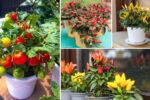Join on WhatsApp
Get the latest updates directly on WhatsApp – motivation, news & more!
Creating a garden that welcomes and supports wildlife is one of the most rewarding things you can do as a gardener. Beyond the aesthetic pleasure of fluttering butterflies, chirping birds, and buzzing bees, a wildlife-friendly garden plays a small but crucial role in supporting biodiversity. One of the most effective ways to attract and sustain native wildlife is by planting native trees. These trees form the backbone of local ecosystems, providing food, shelter, and nesting sites for a variety of species.
Whether you have a large backyard or a small urban plot, you can design a space that encourages a thriving, self-sustaining community of plants, insects, birds, and mammals. Here’s how to create a wildlife-friendly garden using native trees as your foundation.
Why Native Trees Matter
Native trees are those that have evolved naturally in a specific region over thousands of years. Because they co-evolved with local wildlife, they play a vital role in ecological relationships. For instance, many native insects feed exclusively on native plants. Birds, in turn, rely on these insects to feed their young. When you plant a native oak or maple instead of an exotic ornamental, you’re not just adding greenery you’re restoring a chain of life.
Exotic or non-native trees, though beautiful, often fail to support native wildlife. Some even become invasive, crowding out beneficial native species and disrupting local ecosystems. By choosing native trees, you’re making a conscious choice to support a healthier, more balanced environment.
Choose the Right Trees for Your Region
The first step in creating a wildlife-friendly garden is to select native tree species that are well-suited to your local climate, soil, and wildlife. Each region has its own set of trees that thrive naturally and support a specific range of birds, insects, and mammals.
For example, in eastern North America, native oaks are known to support hundreds of caterpillar species, which are a primary food source for nesting birds. In the Pacific Northwest, red alders and Douglas firs serve similar roles. In arid southwestern climates, mesquite and palo verde trees provide shade, nectar, and habitat.
Do a little research to find out what trees are native to your area. Visiting local botanical gardens or speaking with native plant nurseries can offer valuable insights. Try to select a mix of trees that flower, fruit, and shed leaves at different times of the year to provide year-round benefits to wildlife.
Plant for Diversity and Structure
A wildlife-friendly garden thrives on diversity not just in species, but in height and structure. By incorporating a variety of trees with different sizes, shapes, and growth habits, you create multiple layers of habitat.
Tall canopy trees like oaks or elms provide nesting spots for birds and shelter for mammals. Smaller understory trees such as serviceberry, dogwood, or redbud can offer berries and nectar to pollinators and fruit-loving birds. Even shrubby native trees can provide cover for ground-dwelling animals or places for birds to hide from predators.
Diversity also helps ensure that your garden supports a broader range of wildlife species. Different animals have different needs, and a mix of tree types increases the likelihood that your garden will be a safe haven for many of them.
Support Pollinators and Beneficial Insects
One of the most important roles native trees play in a wildlife garden is supporting insect life especially pollinators like bees, butterflies, and moths. Many native trees produce nectar and pollen that attract these vital species, which in turn help pollinate nearby plants.
Flowering trees like native cherries, willows, and hawthorns are particularly valuable for early-season pollinators. Their blossoms provide one of the first food sources after a long winter. Later in the season, trees like basswood or tupelo take over, offering nectar during the summer months.
Beyond pollinators, native trees support the larvae of butterflies and moths, which are a critical food source for birds and bats. By growing trees that attract insects, you’re indirectly feeding the entire food web in your garden.
Provide Food and Shelter Year-Round
When designing your garden, think about how wildlife will use the space throughout the year. Native trees that produce nuts, seeds, and berries are a major food source for animals during fall and winter when other options are scarce.
For instance, oak trees drop acorns that are favored by squirrels, deer, and many birds. Dogwoods and serviceberries produce small fruits that attract thrushes, cardinals, and other songbirds. Evergreen native trees like spruce or pine offer year-round cover, protecting animals from harsh weather and predators.
Dead trees or snags, while often removed for aesthetic reasons, are actually important habitats. They provide nesting cavities for woodpeckers, perches for birds of prey, and homes for small mammals and insects. If it’s safe to do so, consider leaving a snag in your garden as a natural shelter.
Avoid Chemicals and Provide Natural Resources
Creating a wildlife-friendly garden goes beyond planting trees it also involves how you care for your landscape. Avoid using pesticides, herbicides, and synthetic fertilizers, as these can be harmful to the very creatures you’re trying to attract. Instead, focus on building healthy soil through composting and mulching.
Incorporate other natural resources that complement your native trees. A small water feature like a birdbath or shallow pond can make a big difference, especially in urban areas where natural water sources are scarce. Place water sources near shrubs or low branches so animals can drink safely.
You can also leave fallen leaves and small brush piles under your trees. These offer shelter for insects, amphibians, and small mammals, and they return nutrients to the soil as they decompose.
Be Patient and Let Nature Take the Lead
Creating a wildlife-friendly garden with native trees is a long-term commitment. Trees take time to grow, and it may be a few seasons before you see the full range of visitors arrive. But patience pays off. As your trees mature, the garden will begin to take on a life of its own.
You’ll start to notice new birds nesting, butterflies fluttering through branches, and bees busily gathering nectar. Over time, your garden becomes not just a green space but a small sanctuary where nature thrives.
Let go of perfection and embrace a more natural look. Wildlife gardens are rarely manicured. A few chewed leaves, fallen branches, or untidy corners are signs of life, not neglect.
A Living Legacy
By planting native trees and cultivating a wildlife-friendly garden, you’re doing more than creating a beautiful space. You’re helping restore ecological balance in your corner of the world. You’re offering refuge to species that are under pressure from habitat loss, climate change, and urban development.
It doesn’t take a massive yard or unlimited resources to make a difference. Even one well-placed native tree can provide shade, shelter, and sustenance to countless living things. Over time, your garden becomes part of a larger network of green spaces that support biodiversity and make urban and suburban areas more livable for people and for wildlife alike.




